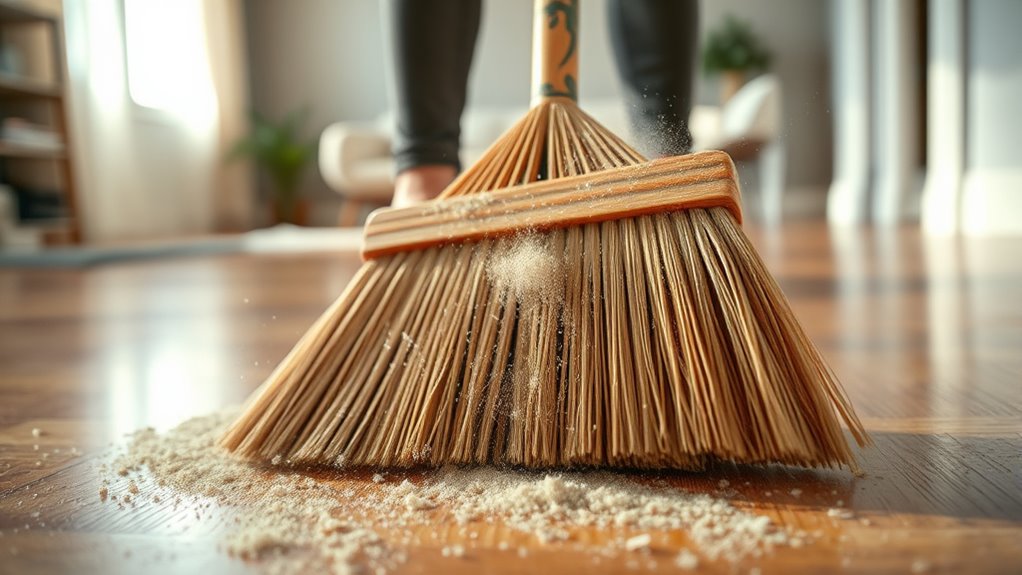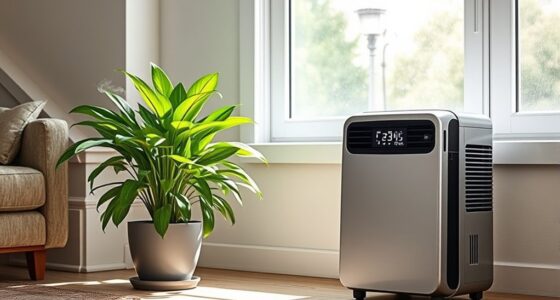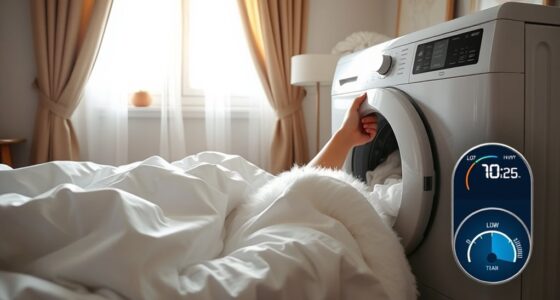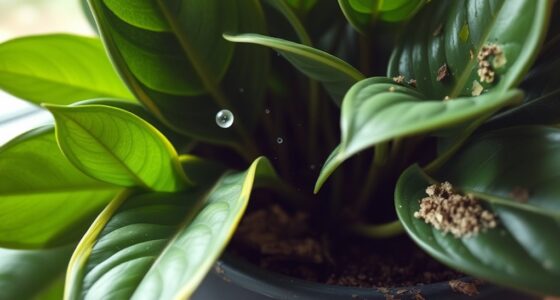Your sponge or microfiber cloth may be the cleaning tool you’re using wrong. If you don’t wash or replace them regularly, they can harbor bacteria, mold, and dust, releasing harmful particles into your air. Overusing harsh chemicals or not ventilating properly worsens the problem by trapping toxins indoors. Keep your tools clean, switch to eco-friendly options, and guarantee good airflow. Want to know how proper techniques can make your home safer? Keep going to find out more.
Key Takeaways
- Using dirty sponges spreads bacteria and airborne pollutants, worsening indoor air quality.
- Overspraying disinfectants without proper ventilation releases harmful chemicals into the air.
- Improper mop maintenance can release dust and microbes, polluting indoor environments.
- Rushing cleaning or applying excessive force can stir up allergens and dust particles.
- Neglecting filter or tool upkeep allows pollutants to circulate, degrading air purity over time.
The Common Cleaning Tool You Might Be Misusing
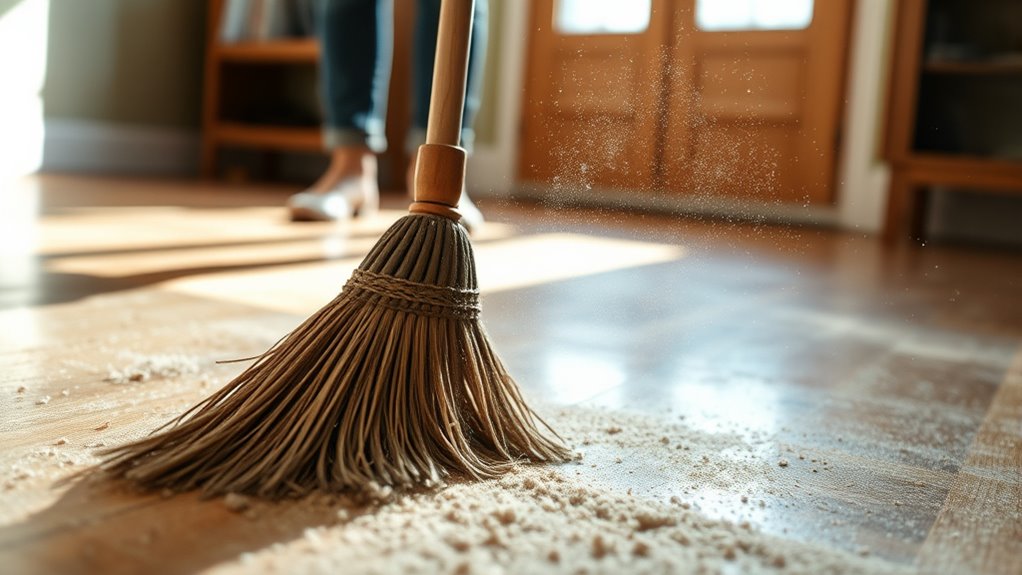
Many people assume that using a mop or sponge is simple, but improper techniques can reduce their effectiveness and even cause damage. Cleaning myths often lead to tool misconceptions, making you believe these tools are foolproof. For example, some think that using a dirty sponge actually cleans better because it traps grime, but that’s a myth. Reusing unclean sponges spreads bacteria and dirt, reducing cleaning efficiency. Similarly, many believe mops should be soaked in harsh chemicals or water, but over-saturation can damage floors or prevent proper cleaning. Tool misconceptions cause you to overlook proper maintenance and usage, which can lead to ineffective cleaning and potential health risks. Knowing the right way to use these tools guarantees a cleaner, safer home, free from hidden pollutants. Additionally, understanding the proper cleaning tools and techniques can help prolong the lifespan of your equipment, such as ensuring your mop maintenance is up to date.
How Incorrect Use Releases Toxins Into Your Home
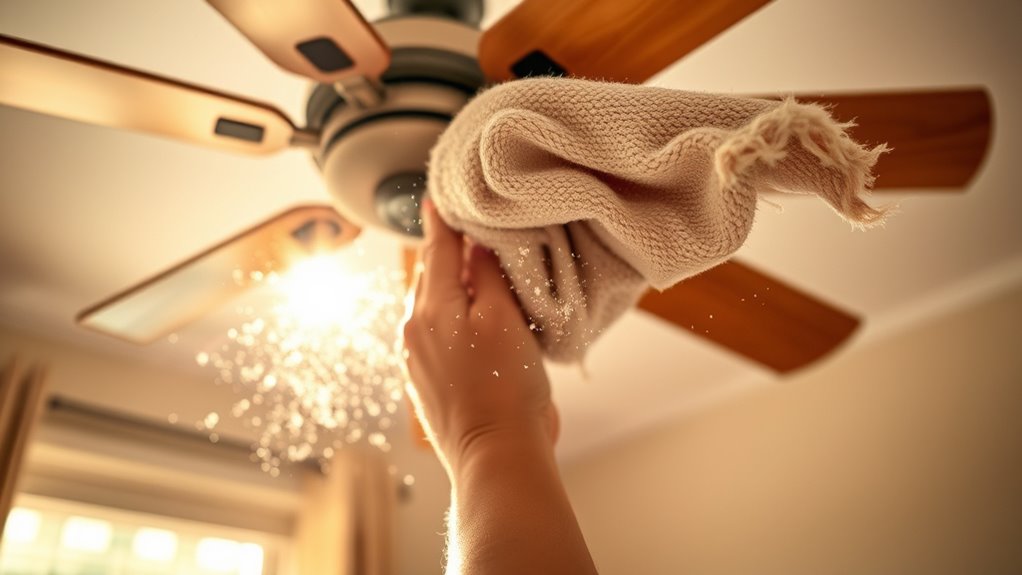
Using cleaning tools improperly doesn’t just reduce their effectiveness; it can also release harmful toxins into your home. When you misuse them, airborne toxins like volatile organic compounds (VOCs) and dust particles become airborne, creating cleaning hazards for your respiratory health. For example, overspraying disinfectants or cleaning sprays can release chemicals that linger in the air. A lack of proper ventilation can exacerbate these issues, trapping airborne toxins indoors.
Signs You Are Not Using Your Cleaning Tool Properly
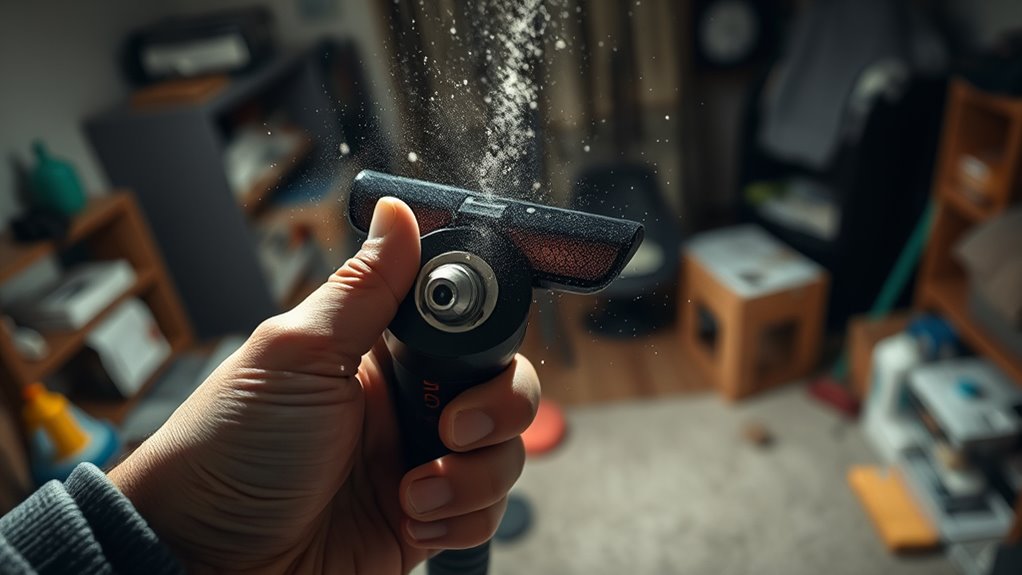
If your cleaning results are lacking, you might be using your tools improperly. Signs include incomplete cleaning patterns, applying too much force, or ignoring filter maintenance. Recognizing these issues helps you clean more effectively and extend your tools’ lifespan. Additionally, ensuring your vacuum or cleaning device has the appropriate filter replacement indicators can prevent pollutants from resettling into the air.
Incomplete Cleaning Patterns
Incomplete cleaning patterns often indicate you’re not using your cleaning tool effectively. When you miss spots or clean unevenly, airborne particles can linger, reducing overall cleaning efficiency. This not only leaves your surfaces less dust-free but can also increase dust resuspension into the air you breathe. If you notice dust buildup in certain areas after cleaning, it’s a sign your technique isn’t thorough enough. Proper cleaning involves consistent, overlapping motions that cover every surface area. Skipping sections or moving too quickly can create gaps where dirt and airborne particles remain. Improving your pattern ensures you’re effectively removing pollutants, making your cleaning more efficient and reducing the risk of airborne contaminants polluting your indoor air. Proper technique is key to better cleaning results and healthier indoor air quality. Additionally, using the right cleaning tools with high contrast ratios can help you see which areas need more attention, ensuring no spots are missed.
Excessive Force Usage
Applying too much force when cleaning can cause damage to surfaces and wear out your tools faster. When you press down hard on your vacuum, it may temporarily improve cleaning, but it often diminishes vacuum efficiency and disrupts dust containment. Excessive force prevents the vacuum from maintaining proper suction, allowing dust and debris to escape back into the air. Additionally, pressing too hard on surfaces can scratch or gouge materials, leading to costly repairs. Instead, let the vacuum’s design do the work by moving smoothly and steadily. Focus on proper technique rather than brute strength. This approach not only preserves your tools but also ensures that dust is effectively contained within the vacuum, reducing airborne pollutants and improving overall indoor air quality. Using the right technique can enhance the effectiveness of your cleaning efforts and support healthier indoor environments consistent messaging.
Neglecting Filter Maintenance
Neglecting filter maintenance can considerably reduce your cleaning tool’s efficiency and lifespan. When you ignore regular filter checks, filter neglect leads to clogged or dirty filters that restrict airflow and trapping capacity. This oversight not only hampers performance but also increases the risk of circulating pollutants and allergens indoors. Proper filter care is essential to ensure your device functions optimally and maintains healthy indoor air quality. Regularly cleaning or replacing filters is vital for ideal operation and to prevent pollution of your indoor environment. Skipping this step can undo all your other cleaning efforts.
The Hidden Dangers of Improper Cleaning Techniques
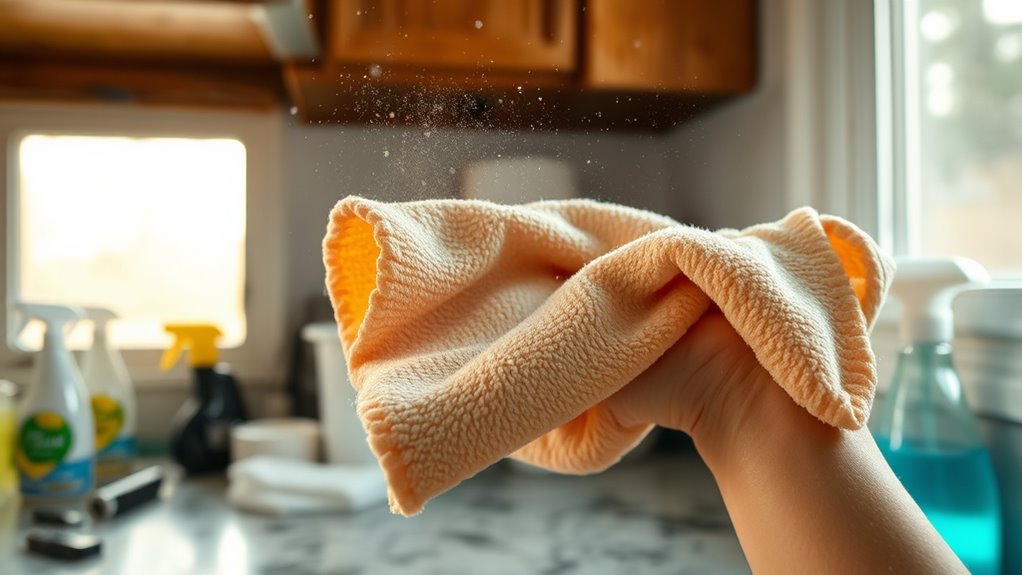
Even when you think you’re cleaning thoroughly, improper techniques can hide serious risks. Rushing through cleaning or using the wrong tools can stir up airborne allergens, making allergies worse and triggering asthma attacks. Using excessive force or neglecting proper ventilation can also cause chemical residues from cleaning products to linger on surfaces, which can be harmful when inhaled or touched. If you don’t rinse surfaces properly or leave residues behind, you risk exposing yourself and your family to irritants that can compromise indoor air quality. Additionally, dust and dirt can resuspend into the air, increasing pollutants. These hidden dangers often go unnoticed, but they can lead to long-term health problems if you don’t adopt better cleaning habits. Understanding proper techniques can help minimize these risks and improve your indoor environment.
Tips for Using Your Cleaning Tool Safely and Effectively
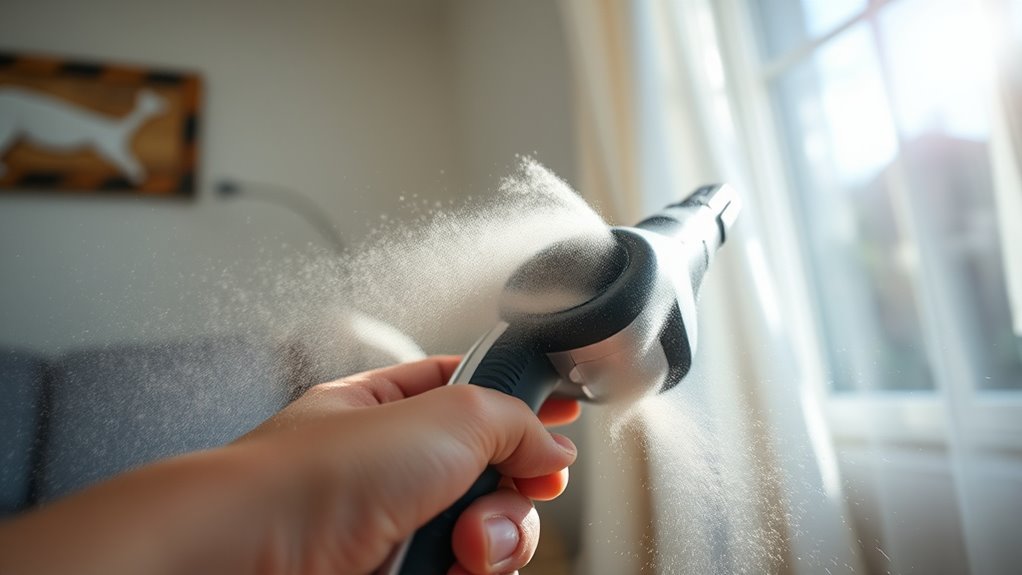
Using your cleaning tools correctly is key to getting the best results and staying safe. Make sure you follow proper techniques, choose the right products, and keep the area ventilated. These simple tips help prevent accidents and guarantee your cleaning is both effective and safe. Incorporating air purifiers with advanced HEPA filters can further improve indoor air quality by reducing airborne particles released during cleaning.
Proper Technique Matters
To get the best results from your cleaning tools, you need to use proper technique. Start by paying attention to how you handle the tool—avoid pressing too hard, which can spread chemical residues and allergens into the air. Always follow the manufacturer’s instructions to guarantee thorough cleaning without dispersing allergy triggers. When wiping surfaces, work in gentle, overlapping strokes to prevent stirring up dust and particles that can worsen allergies. Regularly cleaning or replacing your tool’s filters and pads helps minimize airborne contaminants. Also, ensure your workspace is well-ventilated during and after cleaning to help dissipate any lingering chemical residues or allergens. Incorporating an air purifier can further reduce airborne particles and improve indoor air quality. Using proper technique reduces the risk of polluting your indoor air and keeps your home healthier.
Use Appropriate Products
Choosing the right cleaning products is essential for safety and effectiveness. Use eco-friendly, low-chemical cleaners whenever possible to reduce indoor air pollution. Read labels carefully to avoid harmful ingredients that can irritate your lungs or pollute your air. An air purifier can help capture airborne particles from cleaning products, improving indoor air quality. Stick to a consistent cleaning schedule to prevent buildup, which minimizes the need for harsh chemicals. Always test new products on a small area first to prevent damage. If you’re using a multi-purpose cleaner, ensure it’s suitable for your surfaces. Proper product selection not only protects your health but also ensures your cleaning efforts are truly effective. Adjust your routine as needed to maintain a safe, clean environment.
Ventilate During Cleaning
Proper ventilation during cleaning helps remove airborne pollutants from cleaning products and dust, reducing your exposure to irritants. To improve air circulation, open windows and doors whenever possible, creating cross-ventilation. Use fans strategically to direct airflow outside, helping pollutants escape quickly. Implement ventilation strategies like exhaust fans in kitchens and bathrooms, which can considerably reduce indoor pollutant levels. Avoid cleaning in sealed or poorly ventilated spaces, as this traps dust and chemicals indoors. Prioritize ventilation before, during, and after cleaning sessions to ensure pollutants don’t linger. Effective air circulation not only clears out airborne irritants but also speeds up drying times for cleaning solutions, making your space safer and healthier. Additionally, using proper cleaning tools can help minimize dust and chemical dispersal during cleaning. Good ventilation is a simple but essential step for safe, effective cleaning.
Understanding the Impact of Dust and Particles on Indoor Air Quality
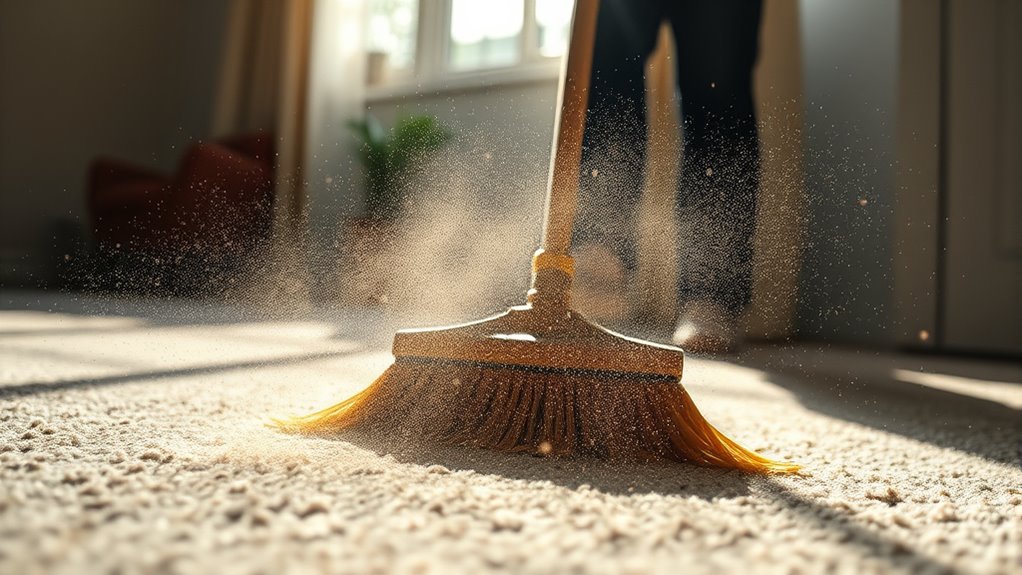
Have you ever wondered how dust and tiny particles affect the air you breathe indoors? These particles can settle on surfaces or stay suspended, worsening air quality and triggering allergies or respiratory issues. Dust often contains allergens, bacteria, and chemicals that pollute the air. Using air purifiers can help trap these harmful particles, improving your indoor environment. Additionally, indoor plants act as natural filters, absorbing some airborne toxins and increasing humidity. However, without proper cleaning, dust can quickly accumulate, negating these benefits. Understanding the impact of dust and particles highlights why regular cleaning and choosing the right tools matter. Keeping the air clean isn’t just about ventilation; it’s about actively reducing the particles that compromise your health and comfort every day.
The Role of Proper Maintenance in Reducing Pollution
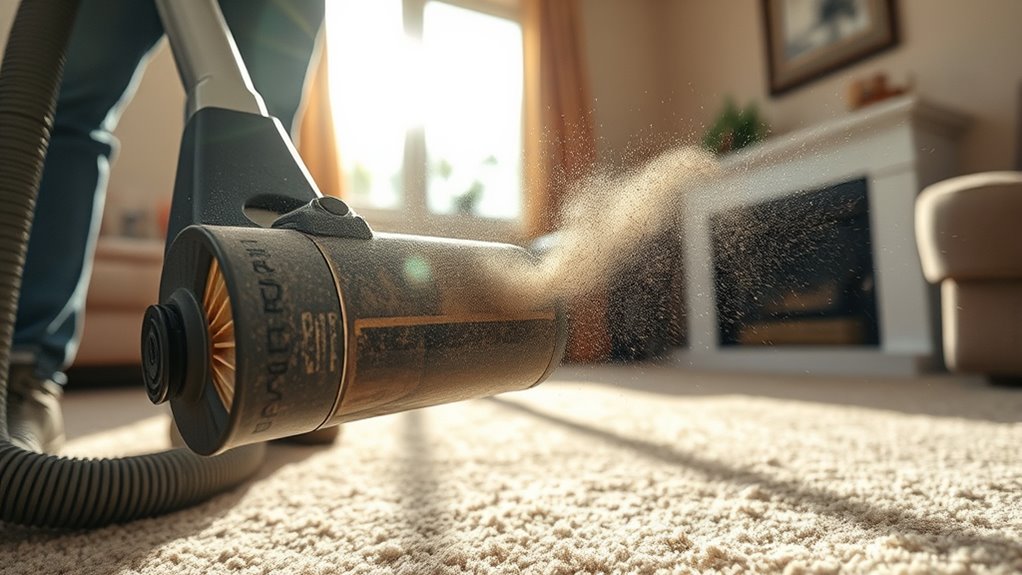
Regular maintenance of your cleaning tools and equipment plays a crucial role in minimizing indoor pollution. When you keep vacuums, mops, and filters clean and well-maintained, you prevent the buildup of dust, mold, and allergens that can degrade air quality. Dirty filters or worn-out tools release trapped particles back into the air, increasing pollution levels. Regularly replacing filters, cleaning brushes, and checking for damage ensures your tools operate efficiently. This not only improves cleaning effectiveness but also markedly reduces airborne contaminants. Proper maintenance helps prevent the circulation of pollutants, supporting healthier indoor environments. By staying on top of maintenance tasks, you actively contribute to pollution reduction and maintain better air quality in your home.
Choosing the Right Cleaning Tools for a Healthier Home
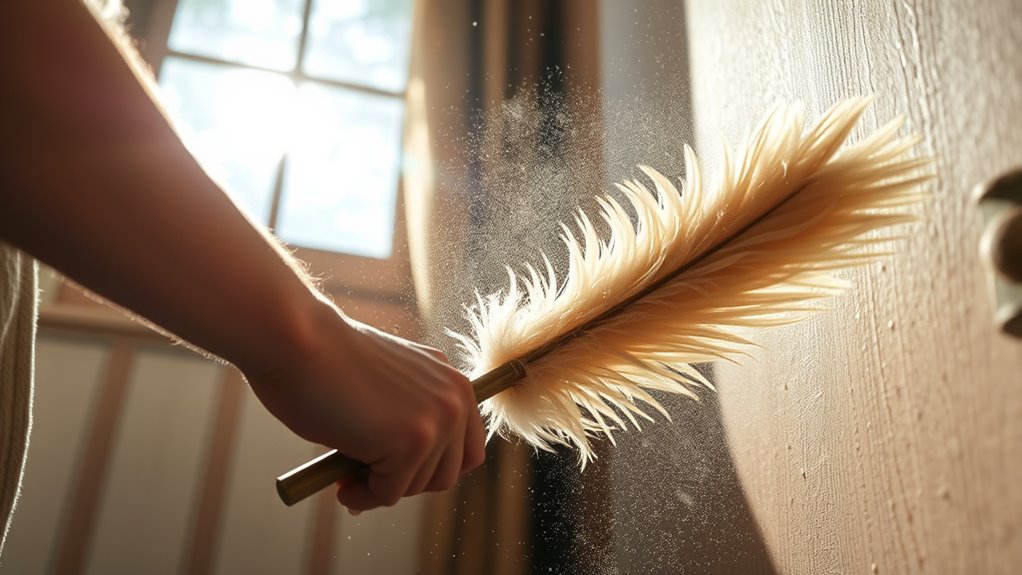
Choosing the right cleaning tools can make a big difference in your home’s air quality and overall health. Pay attention to the materials of your tools, as some can release pollutants or irritants. Opting for eco-friendly options helps guarantee you’re cleaning effectively without compromising your indoor environment.
Material Matters for Cleaners
Selecting the right cleaning tools starts with understanding the materials they’re made from, as this directly impacts your home’s cleanliness and your health. Choosing eco-friendly and non-toxic materials reduces indoor air pollution and improves air filtration. Consider these factors:
- Opt for natural fibers like cotton or bamboo for dust cloths and mop heads to minimize chemical exposure.
- Avoid synthetic plastics that can shed microplastics and release harmful fumes over time.
- Look for stainless steel or untreated wood handles that resist bacteria and don’t emit toxins.
- Check labels for chemical safety; tools made from safe, non-toxic materials support healthier indoor air quality and reduce allergen buildup.
Material choice directly influences chemical safety and air filtration, helping you create a cleaner, safer home environment.
Effectiveness vs. Air Quality
While effective cleaning is essential for maintaining a healthy home, it’s equally important to contemplate how your tools impact indoor air quality. Some cleaning devices may remove dirt and grime but can also stir up allergens and mold spores, worsening air quality. For mold prevention, using tools like HEPA-filter vacuums can trap fine particles that traditional vacuums miss, reducing airborne mold spores. When it comes to allergen control, choosing tools that minimize dust dispersal—such as microfiber cloths or sealed systems—helps prevent allergens from lingering in the air. Balancing cleaning effectiveness with air quality means selecting tools designed to trap and contain pollutants rather than disperse them. Properly chosen tools support a healthier environment by effectively cleaning while safeguarding indoor air from pollutants.
Eco-Friendly Tool Choices
Opting for eco-friendly cleaning tools not only benefits the environment but also promotes healthier indoor air quality. To make smarter choices, consider these options:
- Select tools made from sustainable materials like bamboo or recycled plastics.
- Look for eco friendly brands committed to reducing chemical use and waste.
- Choose reusable options such as microfiber cloths or washable mop heads.
- Avoid single-use plastics by investing in durable, long-lasting tools.
Simple Changes That Can Improve Your Cleaning Routine
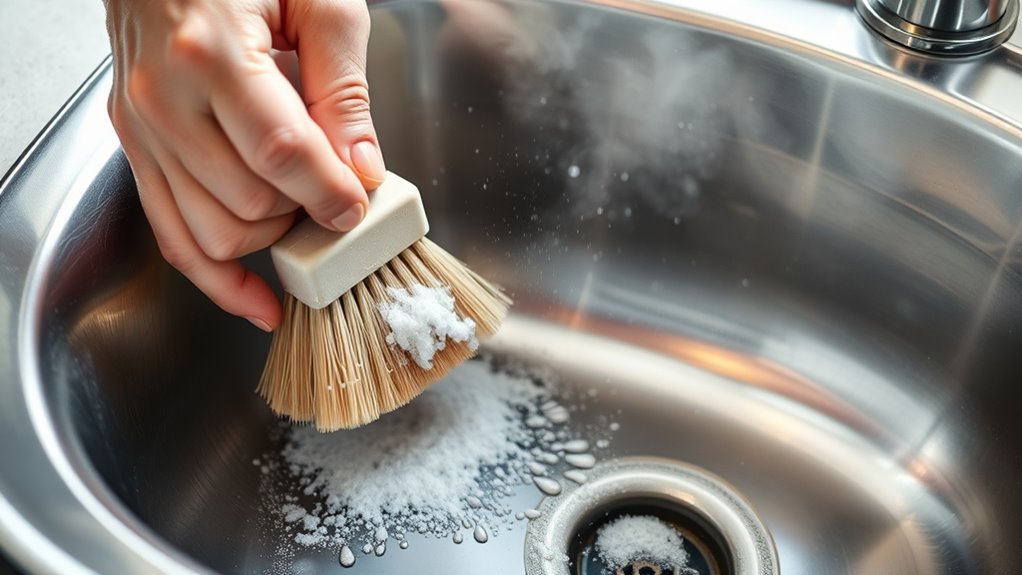
Making small adjustments to your cleaning routine can lead to noticeable improvements in efficiency and results. Start by regularly washing your bedding and curtains to reduce dust mites and allergen buildup. Use a vacuum cleaner with a HEPA filter to trap tiny particles that trigger allergies. When dusting, opt for microfiber cloths instead of traditional dusters, which can spread allergens rather than remove them. Pay special attention to overlooked spots like baseboards, vents, and behind furniture. Incorporating these simple steps helps prevent allergen accumulation and improves indoor air quality. Additionally, cleaning more frequently prevents dust mites from thriving and reduces the need for harsher chemicals. These small changes make your routine more effective and create a healthier environment for you and your family.
Expert Advice on Minimizing Air Pollution During Cleaning
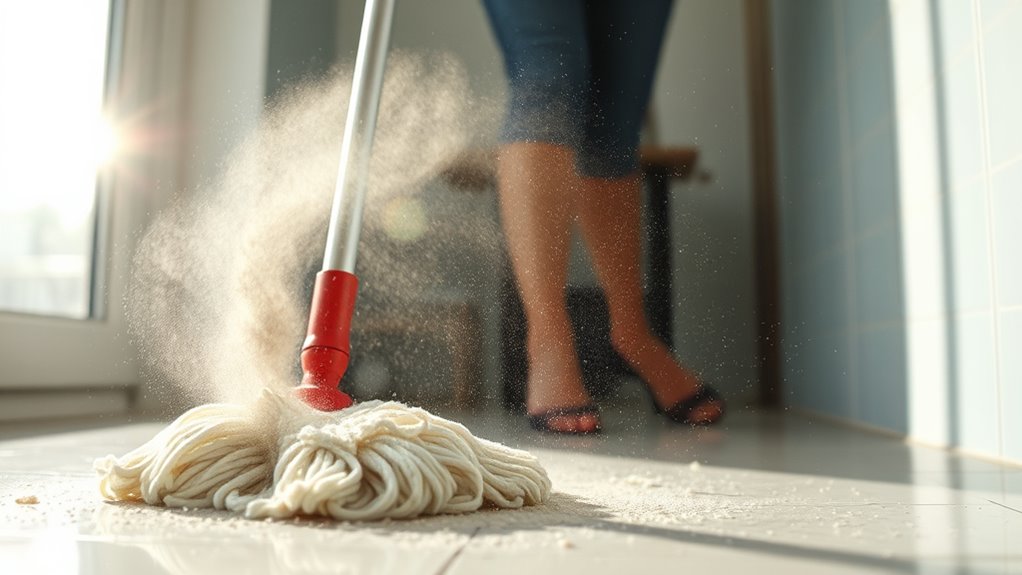
To minimize indoor air pollution during cleaning, it is essential to choose the right tools and techniques. First, use HEPA-filter vacuums to trap mold spores and allergens effectively. Second, avoid harsh chemical cleaners; opt for natural or non-toxic options to reduce airborne irritants. Third, clean surfaces frequently to prevent allergen buildup and mold growth. Fourth, open windows or run an air purifier during and after cleaning to improve airflow and remove airborne particles. These steps help keep your indoor air cleaner, protecting you from respiratory issues caused by pollutants. By selecting proper equipment and implementing effective practices, you markedly reduce the risk of airborne mold spores and allergens lingering in your home.
Frequently Asked Questions
Can Using the Wrong Cleaning Products Harm Indoor Air Quality?
Using the wrong cleaning products can harm your indoor air quality by increasing VOC emissions and leaving chemical residues. These emissions release harmful fumes that can irritate your lungs and trigger allergies. When you choose products with fewer chemicals, you reduce VOCs and chemical residues, making your air safer to breathe. Always read labels and opt for eco-friendly cleaners to protect your indoor environment and your health.
How Often Should I Replace My Cleaning Tools for Optimal Safety?
Imagine your cleaning tools are like fresh leaves on a tree—over time, they wear out and collect dirt. To keep your indoor air safe, follow a consistent cleaning frequency and stick to a replacement schedule, usually every 6 to 12 months. Regularly updating your tools guarantees they work effectively, preventing dust and germs from polluting your air and maintaining a healthier environment for you and your family.
Are Natural Cleaning Tools Safer for Indoor Air Than Synthetic Ones?
Natural alternatives are generally safer for indoor air than synthetic options because they typically contain fewer chemical fumes and volatile organic compounds (VOCs). Synthetic risks include irritations and long-term health issues from chemical exposure. By choosing natural cleaning tools like vinegar, baking soda, or plant-based cleaners, you reduce airborne toxins and create a healthier environment. It’s a simple switch that can markedly improve your indoor air quality and overall well-being.
What Are the Long-Term Health Effects of Inhaling Cleaning-Related Pollutants?
Thinking about inhaling cleaning-related pollutants is like ignoring a slow leak that could flood your home someday. Long-term exposure to airborne toxins from cleaning products can cause respiratory risks, leading to chronic issues like asthma or bronchitis. Over time, these pollutants may weaken your lungs and immune system, increasing your vulnerability to illness. Protect yourself by choosing natural cleaners and ensuring proper ventilation to minimize these health dangers.
How Can I Tell if My Cleaning Routine Is Contributing to Indoor Air Pollution?
To tell if your cleaning routine worsens indoor air quality, look for air quality indicators like increased odors, dust, or respiratory irritation. Pay attention to pollutant sources such as strong chemical smells or lingering fumes after cleaning. If you notice these signs, it’s a good idea to improve ventilation, switch to eco-friendly products, and regularly clean surfaces to reduce airborne pollutants and keep your indoor air healthier.
Conclusion
By using your cleaning tools correctly, you not only keep your home spotless but also protect your air quality. For example, switching from a traditional mop to a microfiber one and cleaning it regularly can considerably reduce dust and toxins. Remember, small adjustments—like proper technique and maintenance—make a big difference. Take control of your cleaning routine today to create a healthier, safer environment for you and your loved ones.
